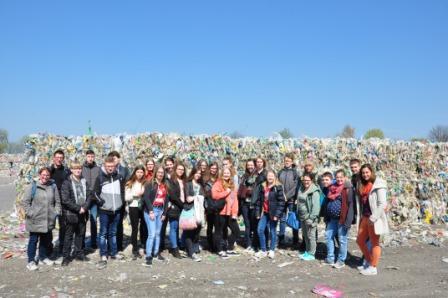On 15 April 2019, our LiP group visited a branch of the company SUEZ in Ochtendung. SUEZ is an international company founded in France to collect, sort and process the waste of our “green bins”. This green bin, which is a yellow bin or a yellow sack in other areas in Germany, is used to collect plastic and metal packaging.

When we arrived, our group was divided into two smaller groups because our group of 25 students and 4 teachers was too big for a tour of their sorting plant. One group went to look at their sorting machines while the others stayed at the conference room to listen to a lecture.
During the lecture we got a lot of information about SUEZ, sorting different types of refuse and what they do with our waste.
In 1991 Germany introduced a new law to reduce the amount of waste that went to landfills or had to be incinerated and to improve recycling. Companies had to pay money for collecting, sorting and further processing of the packaging waste their products created. That is why the company “Dual System Germany” with its logo “Grüner Punkt” (in English “Green Point”) was founded. It is part of the “dual system” that takes care of our packaging waste. SUEZ is a similar company, depending on where you live the second or third most important one. About 18-19 tonnes of waste arrive in Ochtendung per hour.
During the guided tour through their sorting facility we saw most of their machines. They showed us the place where the lorries arrive, how the waste is scanned and separated and also the place where everything is monitored.
- First, a machine cuts open the bags and sacks.
- After that they sieve the waste to separate small and big waste and to take out foil.
- Then it is separated into the different materials, e.g. iron is taken out with a magnet and the different kinds of plastic are sorted with scanners and air nozzles, like the ones we saw at TOMRA. According to the guide there are 17 TOMRA-sorting machines in use, which are upgraded regularly.
- But because some pieces of packaging still end up in the wrong stream of material, in the end several people have to control the already separated waste before the sorted plastic is pressed into bunches of PP, PET, etc. In the photo taken of our group you can see these bunches in the background.
25% of all the waste brought there is sorted out and burned (waste that does not belong in the green bin and waste that slips through the machines without being noticed). This is necessary to make other waste which does not burn so well burn better. They said that the other 75% were recycled or downcycled completely. Therefore the bunches are sold to other companies that process them further.
When we asked them why there was so much waste in the sea, they told us that it was not their fault at all, because Germany was the second best recycler after the Netherlands. They reacted quite defensively to every question we asked and tried to make us think they were innocent and great. Though we were not sure whether we could believe every word they said, we think that is was a very interesting and informative day for our LiP group, and we are already looking forward to the next trip we will make!
If you are interested in reading an article written in German about our outings to explore the German waste disposal system, visit our school's website.